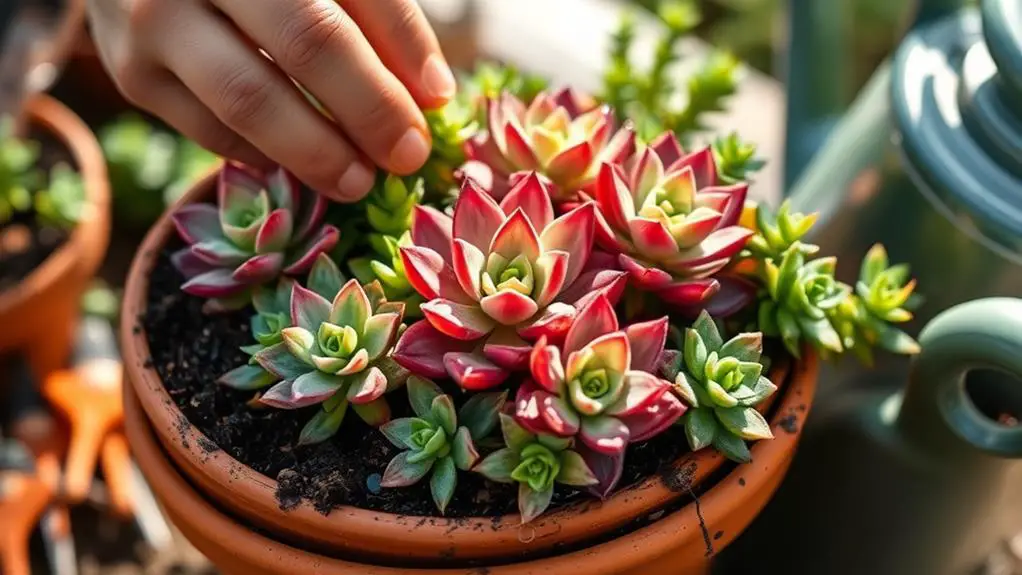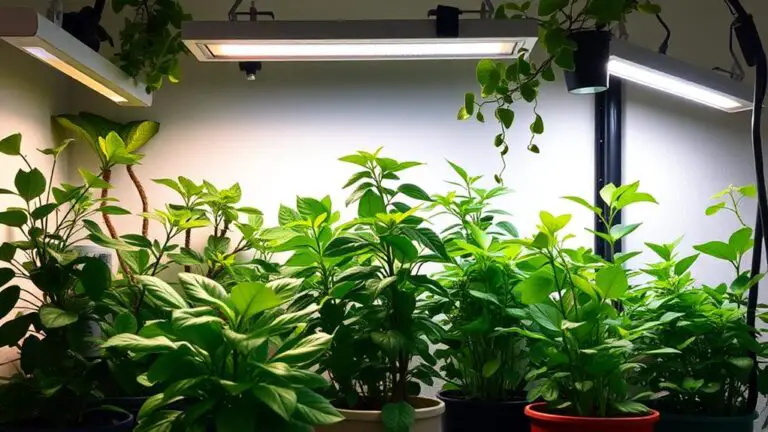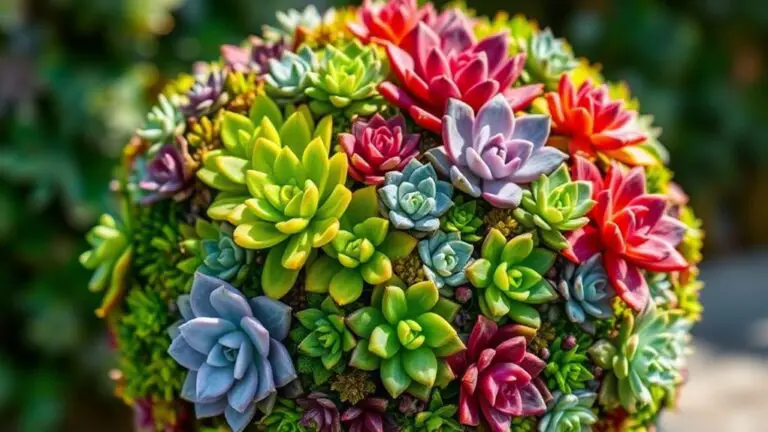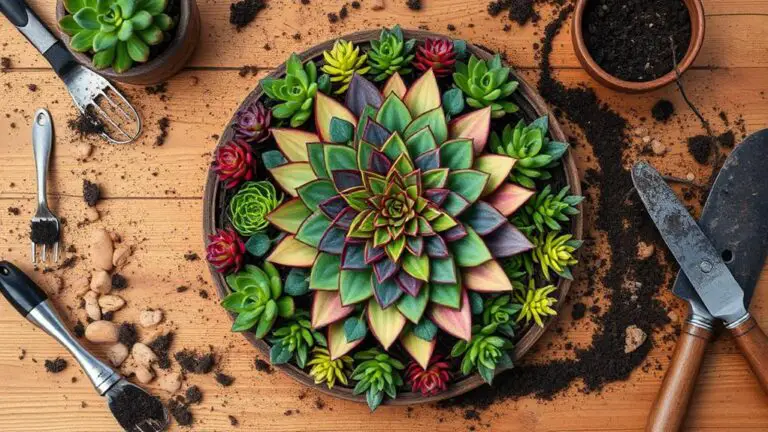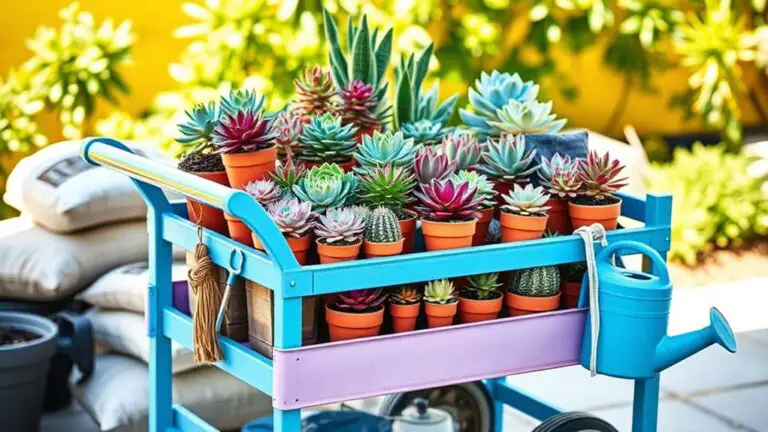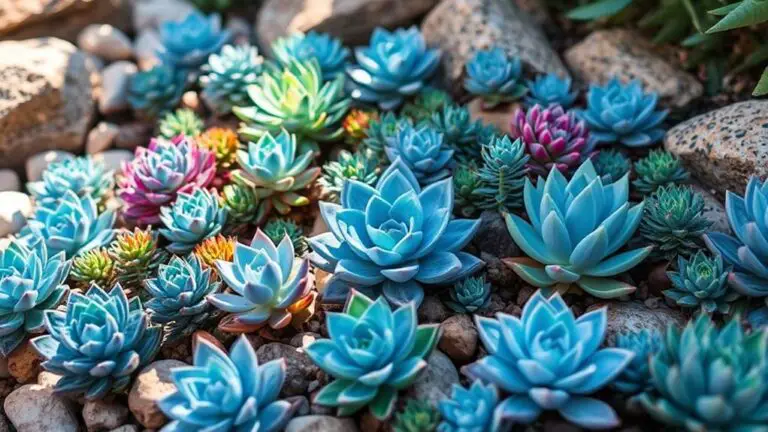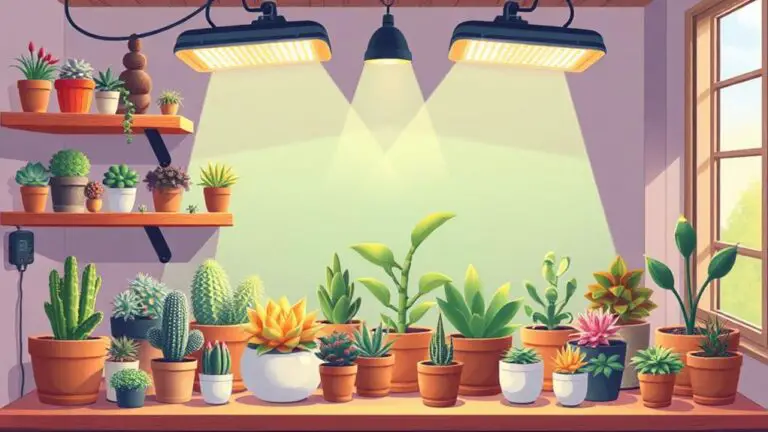10 Tips to Care for Sedum Succulents
If you've ever wondered how to keep your sedum succulents thriving, you're in the right place. These resilient plants are surprisingly easy to care for, but they do have specific needs. For starters, they crave at least six hours of bright sunlight each day and require well-draining soil to avoid root rot. You'll also need to adjust your watering habits based on the season and be mindful of their fertilizer and pruning needs. Curious about the best way to propagate or protect them from pests? Let's explore these essential tips to guarantee your sedums stay healthy and vibrant.
Light Requirements
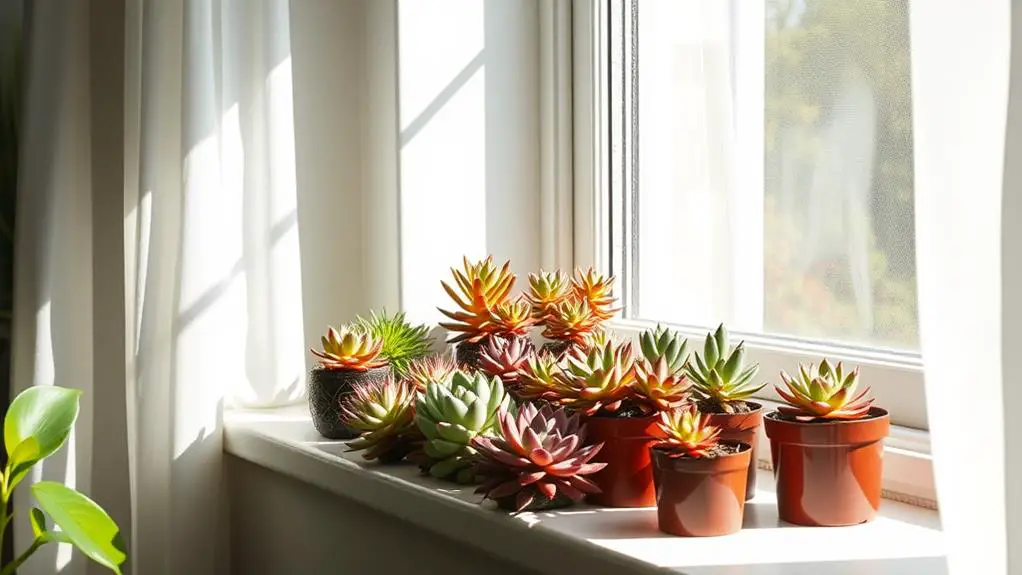
Sedum succulents generally need at least six hours of bright, direct sunlight daily to thrive and guarantee healthy growth. This light requirement secures that your sedum plants remain healthy and vibrant.
Providing full sun is ideal for most sedum varieties, as it promotes blooming and prevents leggy growth. When sedum doesn't get enough sunlight, it tends to stretch out, becoming weak and spindly. This leggy growth is a clear sign that your plant needs more light.
While full sun is preferred, some sedum types can tolerate partial shade. However, keep in mind that this might lead to reduced blooming and less robust growth. If you live in an extremely hot, dry climate, offering afternoon shade can protect your sedum from excessive heat damage, safeguarding it in prime condition.
When caring for your sedum, remember that light is one of the most essential factors. Without adequate sunlight, even the best care efforts might fall short.
If you notice your sedum isn't blooming or looks leggy, consider moving it to a brighter spot or using grow lights. Making sure your sedum gets the right light will help it thrive and flourish beautifully.
Watering Practices
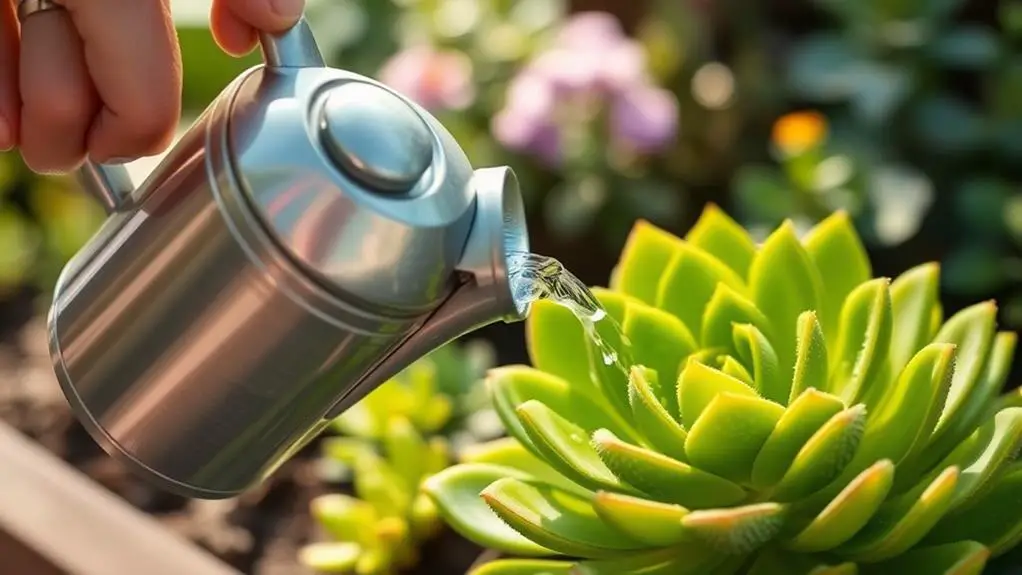
When it comes to watering your sedum succulents, good drainage is key to keeping them healthy.
Make sure your pots have drainage holes to let excess water escape, preventing root rot.
Remember to adjust your watering schedule with the seasons, giving more water in the growing months and much less during winter dormancy.
Importance of Drainage
A crucial aspect of caring for Sedum succulents is ensuring proper drainage to prevent root rot. Sedums thrive in well-draining soil because they're prone to moisture-related issues if the soil retains too much water. To create an ideal environment for your Sedum, mix perlite, sand, or pumice into the soil. This helps excess water escape more quickly and prevents root rot.
It's also essential to use pots with drainage holes. These holes let any extra water flow out, keeping the roots healthy. When you water Sedum, make sure the top inch of soil is dry before you add more water. Overwatering can harm your plants by keeping them too wet, leading to root rot.
During the winter months, Sedums enter a dormant phase and don't need as much water. They're more likely to suffer from root rot in cooler, moist conditions, so reduce how often you water them.
Seasonal Watering Adjustments
As the seasons change, adjusting your watering practices is crucial for keeping your Sedum succulents healthy. In the warmer months, check the top inch of soil before you water. Only water when it's dry to avoid overwatering, which can cause root rot.
During the winter, your Sedum plants go dormant and need much less water. Reduce your watering frequency considerably to match their minimal moisture needs.
If you've recently planted new Sedums, water them weekly during their first year to help them establish strong roots. Once they're established, these succulents are quite drought-tolerant and need less frequent watering.
However, during long dry spells, even established plants might need a bit more water. Make sure any extra water drains thoroughly to prevent moisture retention.
When watering potted Sedums, use a single-hole watering can or try bottom-watering. This targets the soil directly and avoids wetting the sensitive leaves and stems.
Soil Composition
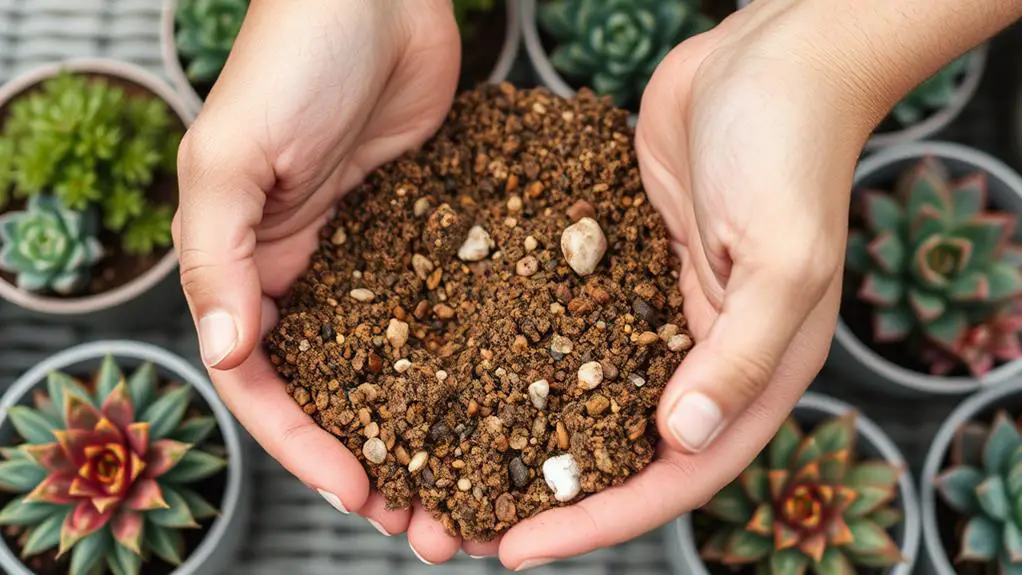
For thriving Sedum succulents, well-draining soil is essential. The right soil composition makes a huge difference in keeping your plants happy and healthy.
Heavy or compacted soils that hold too much water can lead to root rot and fungal diseases, so you'll want to avoid those. Instead, aim for a mix that includes potting soil, perlite, and sand to prevent excessive moisture retention.
Here's a simple guideline to create the perfect soil mix:
- Potting Soil: Use a basic potting soil as the foundation.
- Perlite: Add perlite to enhance drainage. It's lightweight and helps keep the soil from becoming too compact.
- Sand: Mix in some sand to improve the texture and promote aeration.
- Succulent Mix: You can also buy a pre-made cactus or succulent mix, which usually has a neutral to slightly alkaline pH, ideal for Sedums.
Additionally, make sure your pots have drainage holes. This allows excess water to escape, preventing waterlogged conditions that can harm your plants.
Adding pumice, perlite, or grit to your standard potting soil will further support healthy root development. With these tips, your Sedum succulents will thrive beautifully.
Temperature Tolerance
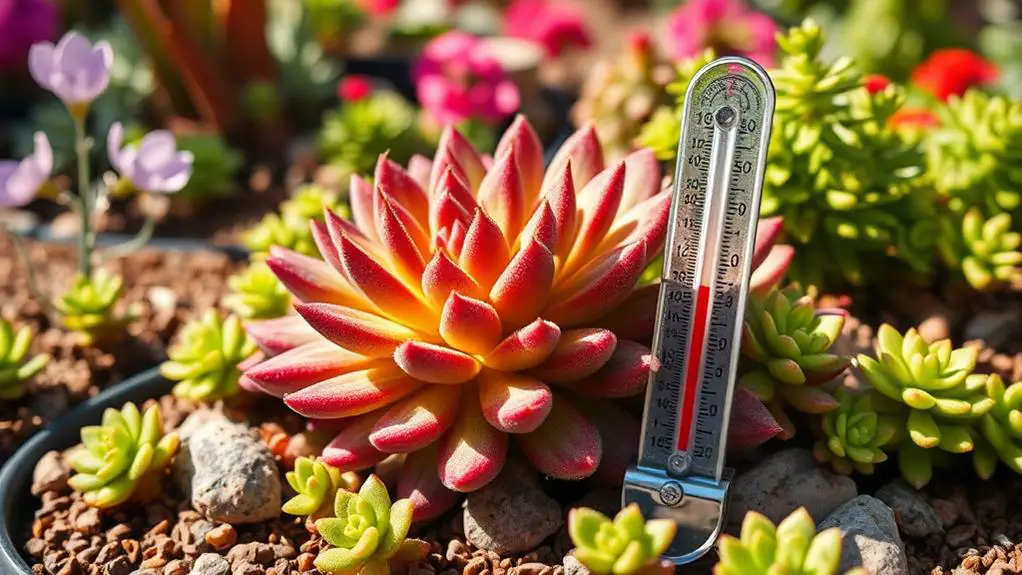
While having the right soil composition is key to keeping your Sedum succulents healthy, understanding their temperature tolerance is equally important. Sedums are incredibly resilient, thriving in a wide range of temperatures. They can handle the chill of cold climates, even as low as -30°F, and the warmth of hot summers, up to 90°F. This versatility makes them suitable for various climate zones.
In hot, dry climates, Sedums are well-adapted and can flourish, but they might need more frequent watering during prolonged heat to avoid stress. When temperatures soar, make sure to check their watering needs more often.
On the flip side, if you live in an area where temperatures dip below 0°F, consider growing your Sedums in pots. This allows you to bring them indoors when it gets too cold, protecting them from potential damage.
During winter, Sedum plants enter dormancy, especially when temperatures drop below 40°F. This means their growth rate slows down, and they need less water.
Keeping an eye on temperature extremes is vital for maintaining your Sedum's health. Both freezing temperatures and excessive heat can stress your plants, so monitor conditions closely.
Fertilizer Needs
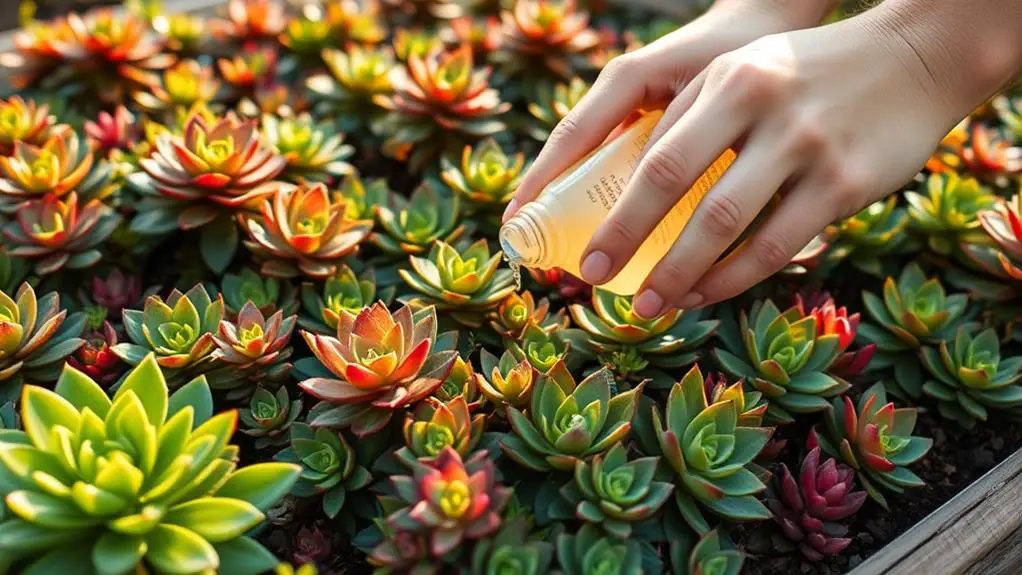
To keep your sedum succulents healthy, it's important to know their fertilizer needs.
You should fertilize them once or twice a year during the growing season, using a balanced, water-soluble fertilizer diluted to half strength.
Early spring is the best time to fertilize to support growth and flowering, while late summer fertilization should be avoided to prevent weak new growth.
Optimal Fertilization Timing
When it comes to fertilizing your Sedum succulents, timing is key to promoting healthy growth. Sedums typically need minimal fertilization, but applying it at the right times can make a difference. The ideal fertilization timing is during the growing season, which starts in spring and continues through early summer. Here are some helpful tips:
- Spring: Begin fertilizing in spring, just as new growth starts. This is when your Sedum succulents are waking up from dormancy and will benefit the most from nutrient input.
- Early Summer: Apply a balanced fertilizer again in early summer to support blooming and overall plant health. This helps sustain growth and vibrant colors.
- Minimal Fertilization: Always use a diluted, balanced fertilizer or compost. Avoid high-nitrogen fertilizers, as they can cause leggy growth. Sedums don't need much, so less is more.
- Dormancy: Reduce or stop fertilizing in winter when Sedums enter dormancy. They need far less nutrient input during this time, and over-fertilizing can harm them.
Regularly assess the health of your Sedum. If it looks stunted or unhealthy, a light application of fertilizer during the growing season might be necessary.
Happy gardening!
Types of Fertilizers
After understanding the importance of ideal fertilization timing, it's equally important to know the best types of fertilizers for Sedum succulents. When it comes to fertilization, Sedum plants benefit from minimal nutrients. You should aim to feed them once or twice during the growing season, which is in spring and summer.
A balanced, diluted liquid fertilizer with a ratio of 10-10-10 works wonders for promoting healthy growth. Alternatively, a specialized cactus/succulent fertilizer is also suitable. These options provide the right nutrients without overwhelming your Sedum.
It's essential to avoid over-fertilization as it can lead to leggy growth and attract pests.
Another great option is adding compost to the soil mix. Compost acts as a slow-release source of nutrients and helps maintain the well-draining soil that Sedums require. This guarantees your succulents get the nutrients they need gradually, supporting their healthy growth.
Application Frequency Guidelines**
For Sedum succulents, the key to proper fertilization lies in moderation. You don't need to fertilize them often; once or twice a year during the growing season is usually enough.
Applying a diluted liquid fertilizer with a balanced N-P-K ratio in the spring or early summer can help promote healthy growth and flowering.
To make fertilizing your Sedum easy, follow these steps:
- Choose the right time: Fertilize in spring or early summer when your Sedum is actively growing. Avoid fertilizing in fall and winter during dormancy.
- Use diluted liquid fertilizer: A balanced N-P-K ratio is best. Over-fertilizing can lead to leggy growth and fewer flowers.
- Add compost: If your soil is nutrient-poor, mix in some compost during the growing season. It provides additional nutrients without the risks of chemical fertilizers.
- Stick to the schedule: Don't fertilize more than once or twice a year. Keeping to this application frequency prevents over-fertilizing.
Pruning and Maintenance
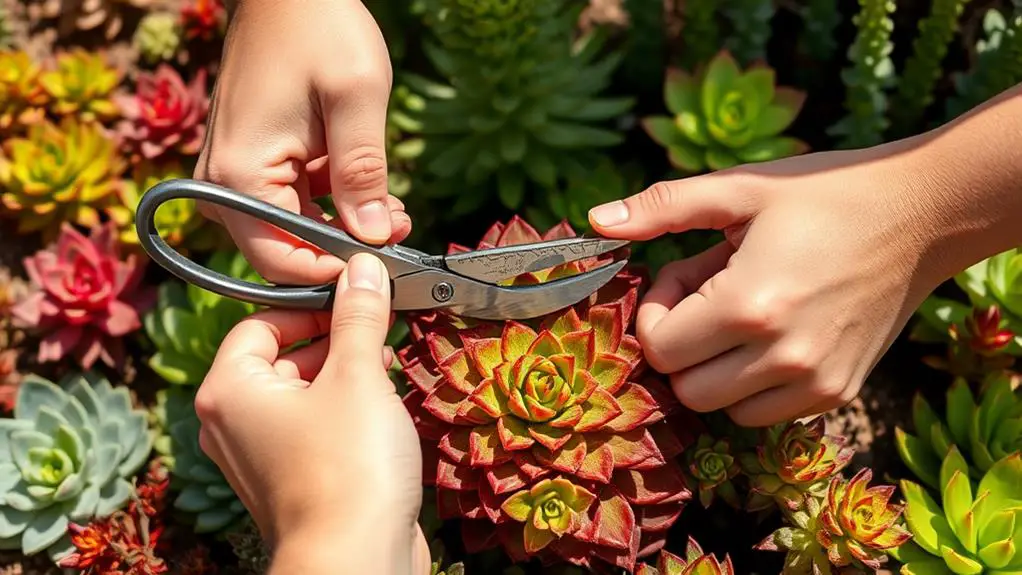
Pruning and maintaining sedum succulents is generally straightforward and minimal, making them a favorite among gardeners. You don't usually need to prune sedum, but pinching back or trimming can encourage bushy growth and help you maintain the desired shape.
For taller varieties, cutting back to ground level in winter can result in healthier foliage and better flowering in the next growing season.
Regular trimming is also helpful for managing overgrown plants. You can do this in spring or early summer to shape the plant effectively. If you leave the seed heads intact during winter, they provide food for birds and add visual interest to your garden, making it lively even during the colder months.
When it comes to fertilization, a little goes a long way. Minimal fertilization during the growing season is beneficial. Adding compost once or twice a year supports healthy growth without overwhelming the plant.
This straightforward care routine helps maintain your sedum succulents in excellent condition, ensuring they thrive and continue to be a beautiful part of your garden. With these simple steps, you'll enjoy the full beauty and benefits of your sedum succulents.
Propagation Methods
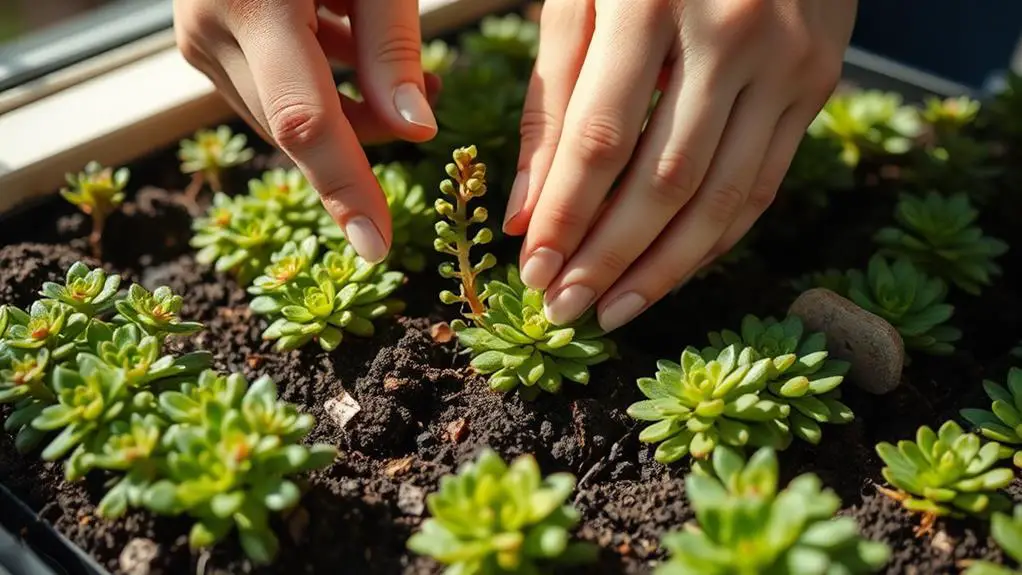
Propagating sedum succulents is a fun and easy way to expand your garden.
You can start with stem cuttings, leaf propagation, or by dividing established clumps.
Just follow some simple steps, and you'll have new plants in no time!
Stem Cuttings Process
Successfully propagating Sedum succulents through stem cuttings is an often rewarding process. Start by choosing healthy 3 to 4-inch stems in the spring, as this season offers the best success rate.
After you've made your cuts, allow the stem cuttings to callous for 2 to 3 days. This step is vital to prevent rot when you plant them in well-draining soil.
Here's a simple guide to follow:
- Select and Cut: Choose 3 to 4-inch healthy stems and cut them cleanly.
- Callous Time: Let the cuttings callous for 2 to 3 days.
- Planting: Place the calloused cuttings in well-draining soil.
- Watering: Only water the cuttings after 2 to 3 days or when the soil is fully dry.
Once your cuttings are planted, place them in an area with indirect sunlight. This location helps avoid stress and dehydration.
It's important to monitor the soil moisture regularly. Overwatering can lead to root rot, which can hinder the propagation process. Instead, let the soil dry out completely before you water again.
This practice promotes healthy root development and guarantees your new plants thrive. With patience and care, you'll soon see your Sedum succulents flourishing!
Leaf Propagation Steps
To propagate Sedum succulents using leaves, start by choosing healthy, plump leaves from a mature plant. Gently twist them off to avoid damaging the stem. Next, allow the detached leaves to callous for 2 to 3 days in a dry, shaded area. This step is vital to prevent rot when you plant them.
Once the leaves are calloused, place them flat on well-draining soil. Don't bury them, as roots will emerge from the base over time. After 2 to 3 days, water the soil lightly. Continue to water only when the soil is completely dry until new roots have developed. Make sure to keep the leaves in indirect sunlight. Too much direct light can scorch them before they establish roots.
Here's a quick reference table for you:
| Step | Details |
|---|---|
| Choose Leaves | Select healthy, plump leaves |
| Remove Leaves | Twist gently to avoid damaging the stem |
| Callous Leaves | Let dry for 2-3 days in a shaded area |
| Place on Soil | Lay on well-draining soil surface |
| Watering and Sunlight | Water lightly, keep in indirect sunlight |
Division Technique Guide**
In the division technique for propagating Sedum succulents, timing is essential. Spring is the best time, as the plant is actively growing. Dig up the entire clump carefully and separate it into smaller sections. Each division should have both roots and leaves to increase the chances of successful replanting.
Follow these steps for a smooth process:
- Prepare the Plant: Dig up the entire Sedum clump. Confirm you've got a sharp, clean tool to minimize plant damage.
- Divide the Clump: Cut the clump into smaller sections, making sure each section has roots and leaves. This boosts the likelihood of successful replanting.
- Allow to Callous: Let the cut sections callous for a few hours or overnight. This helps prevent disease and rot.
- Replant in Well-Draining Soil: Place the calloused sections in well-draining soil. Water lightly to avoid root rot. Confirm the soil dries out before the next watering.
Pest and Disease Control
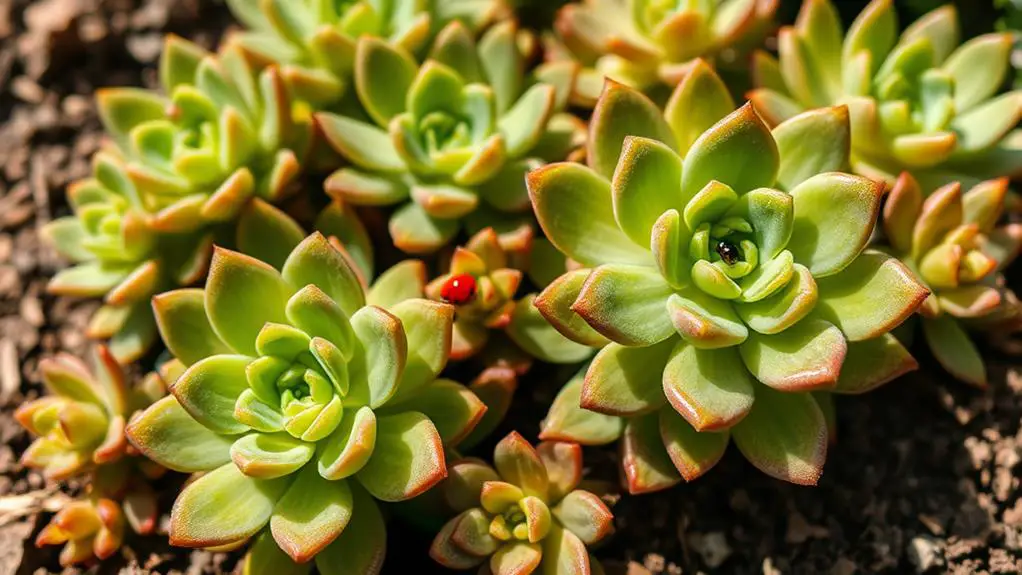
Maintaining healthy Sedum succulents means staying vigilant against common pests and diseases. First, regularly inspect your plants for pests like aphids, mealybugs, and scale. They can be managed with neem oil or insecticidal soap if detected early. Fungal infections, especially in humid conditions, can be prevented by improving soil drainage and removing any damaged foliage promptly.
Overwatering is a common issue that leads to root rot. Make sure the soil dries out completely before watering again. Adequate sunlight is essential; your Sedum needs at least 6 hours daily to thrive and avoid leggy growth. Black soot on leaves often indicates black fungus from honeydew excreted by aphids. Washing the leaves and treating for aphids can solve this issue.
Below is a table summarizing key practices:
| Problem | Solution |
|---|---|
| Pests | Use neem oil or insecticidal soap |
| Fungal Infections | Improve soil drainage, remove foliage |
| Overwatering | Let soil dry completely between waterings |
| Leggy Growth | Provide adequate sunlight (6 hours) |
| Honeydew/Black Fungus | Wash leaves, treat for aphids |
Overwintering Tips
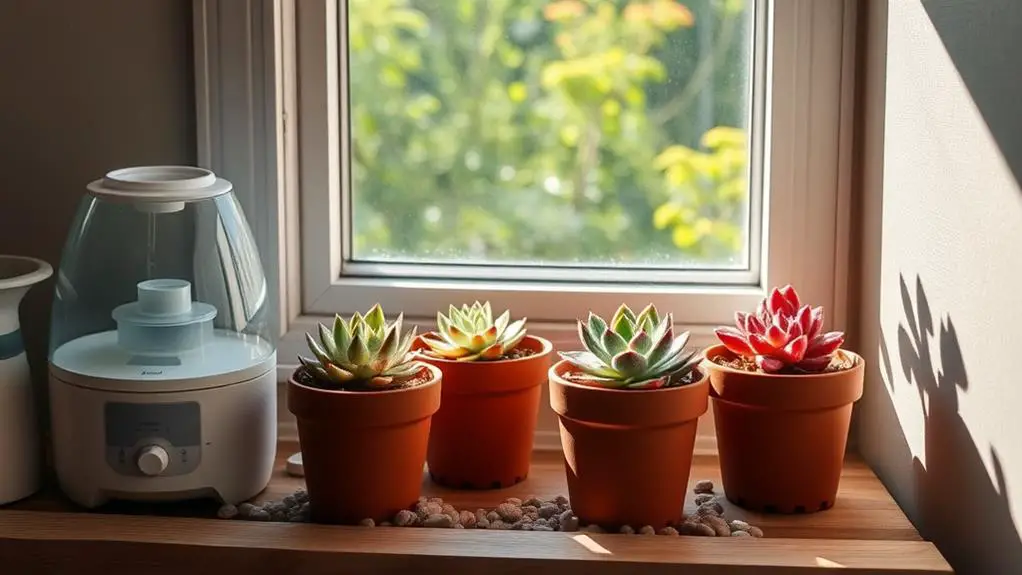
Winter can pose a challenge for Sedum succulents, but with the right approach, you can guarantee your plants thrive even in the coldest months. Overwintering Sedum requires some specific steps to protect them from frost damage and make certain they enter their dormant state properly.
- Move Potted Plants Indoors: When temperatures drop below 0°F, it's essential to bring potted Sedum succulents inside to shield them from frost damage. A south-facing window will provide the necessary light for healthy growth.
- Insulate Outdoor Pots: If you can't bring them indoors, wrap your pots in burlap and bubble wrap for extra insulation against cold temperatures. This added layer helps keep the roots safe from freezing.
- Apply Mulch: For Sedum planted in the ground, a layer of mulch can be a lifesaver. It insulates the roots and protects them from extreme cold, keeping the plants healthy through winter.
- Adjust Watering: During winter, Sedum succulents need less water because they're dormant. Overwatering can lead to root rot, so be sure to monitor and reduce your watering frequency.
Common Issues

Caring for Sedum succulents can be straightforward, yet several common issues might arise that need your attention. Aphids are a frequent problem; you can treat them with a strong water spray or neem oil to keep your plants healthy. If you notice black fungus on the leaves, it's from honeydew secreted by aphids. Washing the leaves and treating the aphids will resolve this issue.
Overwatering can lead to root rot, a common issue for Sedum succulents. To avoid this, monitor your watering habits and guarantee the soil has proper drainage. Fungal infections might also occur in humid conditions. Improve drainage and remove any damaged foliage promptly to prevent the spread of fungi.
| Issue | Solution |
|---|---|
| Aphids | Spray with water or neem oil |
| Black Fungus | Wash leaves; treat aphids |
| Root Rot | Guarantee proper drainage; monitor watering |
Leggy growth often indicates insufficient sunlight or too much nitrogen in the soil. Increase sun exposure and adjust the soil composition if necessary. By addressing these common issues, you'll keep your Sedum succulents thriving and beautiful. Remember, attentive care is key to healthy plants.
Frequently Asked Questions
How Often Should I Water a Sedum Succulent?
Water your Sedum succulent only when the top inch of soil is dry. Typically, this means once a week during growing season. In winter, reduce watering considerably. Always make certain pots have drainage holes to prevent root rot.
How Do You Keep Sedum Looking Good?
To keep Sedum looking good, make certain it gets six hours of sunlight daily, water only when the top inch of soil is dry, use well-draining soil, prune in spring or early summer, and check regularly for pests.
How Do I Make My Sedum Grow Better?
Make certain your Sedum gets six hours of direct sunlight daily. Water only when the top inch of soil is dry. Use well-draining soil and fertilize sparingly. Inspect regularly for pests and diseases to keep it thriving.
Do Sedums Like Full Sun or Shade?
Sedums love full sun, needing at least six hours of direct sunlight daily. While they can tolerate partial shade, they might become leggy and have fewer blooms. Afternoon shade helps in extremely hot climates to prevent damage.
Conclusion
Caring for sedum succulents isn't hard once you know the basics. By giving them plenty of sunlight, using well-draining soil, and adjusting your watering with the seasons, you'll keep them healthy. Don't forget to fertilize lightly in spring and watch for pests. If it gets really cold, protect your plants. And remember, you can easily propagate new plants from cuttings. With these tips, you're all set to enjoy beautiful, thriving sedums!

